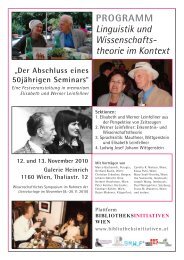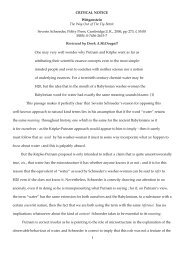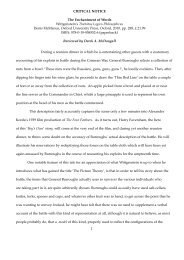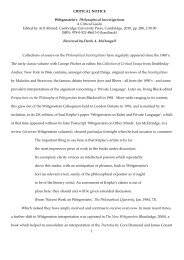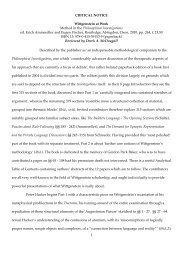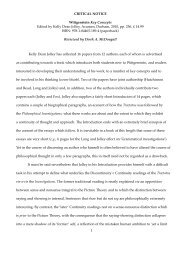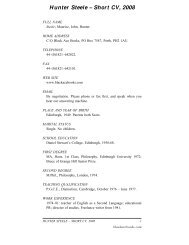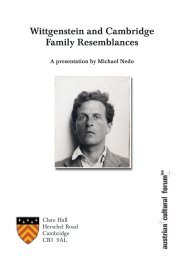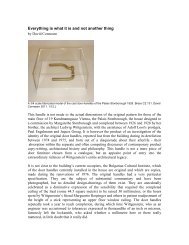The Evolution of the Private Language Argument Aldershot
The Evolution of the Private Language Argument Aldershot
The Evolution of the Private Language Argument Aldershot
You also want an ePaper? Increase the reach of your titles
YUMPU automatically turns print PDFs into web optimized ePapers that Google loves.
question, <strong>the</strong> point that Donagan is making here - along with Ayer, Strawson, Kripke etc. - maynot be thought to be <strong>of</strong> any ultimate significance.Chapter 7 on ‘Ordinary Sensation <strong>Language</strong>’ is largely occupied with a discussion <strong>of</strong>John Cook who, having been introduced to <strong>the</strong> Wittgenstein <strong>of</strong> <strong>the</strong> Investigations by NormanMalcolm and Oets Bousma, was concerned to show that <strong>the</strong> statement ‘I know I am in pain’ hasno proper application as an expression <strong>of</strong> certainty since, in <strong>the</strong> final analysis, someone whopersistently claims to be in pain when he is not - and is nei<strong>the</strong>r a liar nor is making a slip <strong>of</strong><strong>the</strong> tongue - would be regarded not as having inadequate powers <strong>of</strong> inner observation, but <strong>of</strong>having a poor command <strong>of</strong> <strong>the</strong> English language. This conclusion is intended to break <strong>the</strong>hold <strong>of</strong> <strong>the</strong> suggestion made in § 246 that ‘Well, only I can know whe<strong>the</strong>r I am really in pain;ano<strong>the</strong>r person can only surmise it.’ Along with his treatment <strong>of</strong> ‘Ano<strong>the</strong>r person can’t have mypains’ (§ 253) in which Wittgenstein questions what is supposed to count as a criterion <strong>of</strong> identityhere, Cook’s proposals are seen by Neilsen as an important historical step in <strong>the</strong> literatureundermining <strong>the</strong> attractions <strong>of</strong> <strong>the</strong> so-called ‘Cartesian’ approach in which sensations areassimilated into a special category <strong>of</strong> private ‘mental’ as distinct from ‘physical’ object. IfNeilsen’s treatment here seems to be recounting something with which we are now almost to<strong>of</strong>amiliar, this is no doubt because <strong>the</strong> message from Cook that ‘sensations as private objects’is solely <strong>the</strong> result <strong>of</strong> being under <strong>the</strong> influence <strong>of</strong> a false grammatical analogy, has now becomean accepted feature <strong>of</strong> <strong>the</strong> philosophical landscape. Neilsen is describing here what has come tobe known as ‘early Cook’, and it is no doubt some form <strong>of</strong> testimonial when a philosopher’sthinking is divided into ‘earlier’ and ‘later’ periods. Later Cook does not figure in any detail inNeilsen’s coverage <strong>of</strong> <strong>the</strong> literature, which deals primarily with Cook’s three well-known papersfrom <strong>the</strong> 1960’s and 70’s, pointing in particular to <strong>the</strong> now very familiar ‘Human Beings’ inwhich Cook effectively treats § 258 not as a reductio on Malcolm’s lines, but as a devious heuristicdevice indicating that when severed from <strong>the</strong>ir ordinary contexts <strong>of</strong> application in multifarioushuman activities, attempts to talk about naming and remembering sensations by disembodied20





